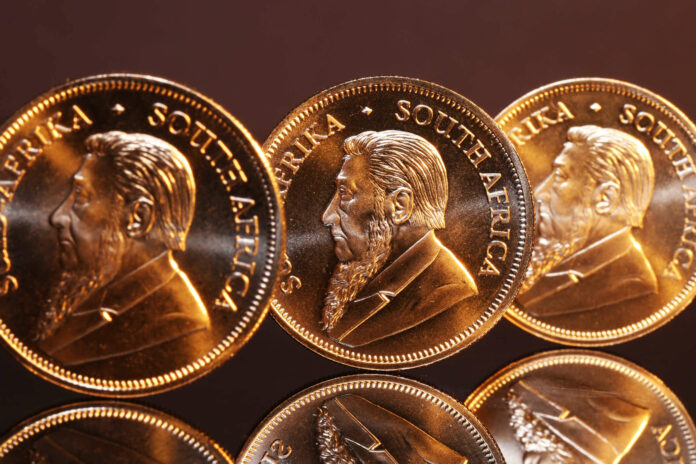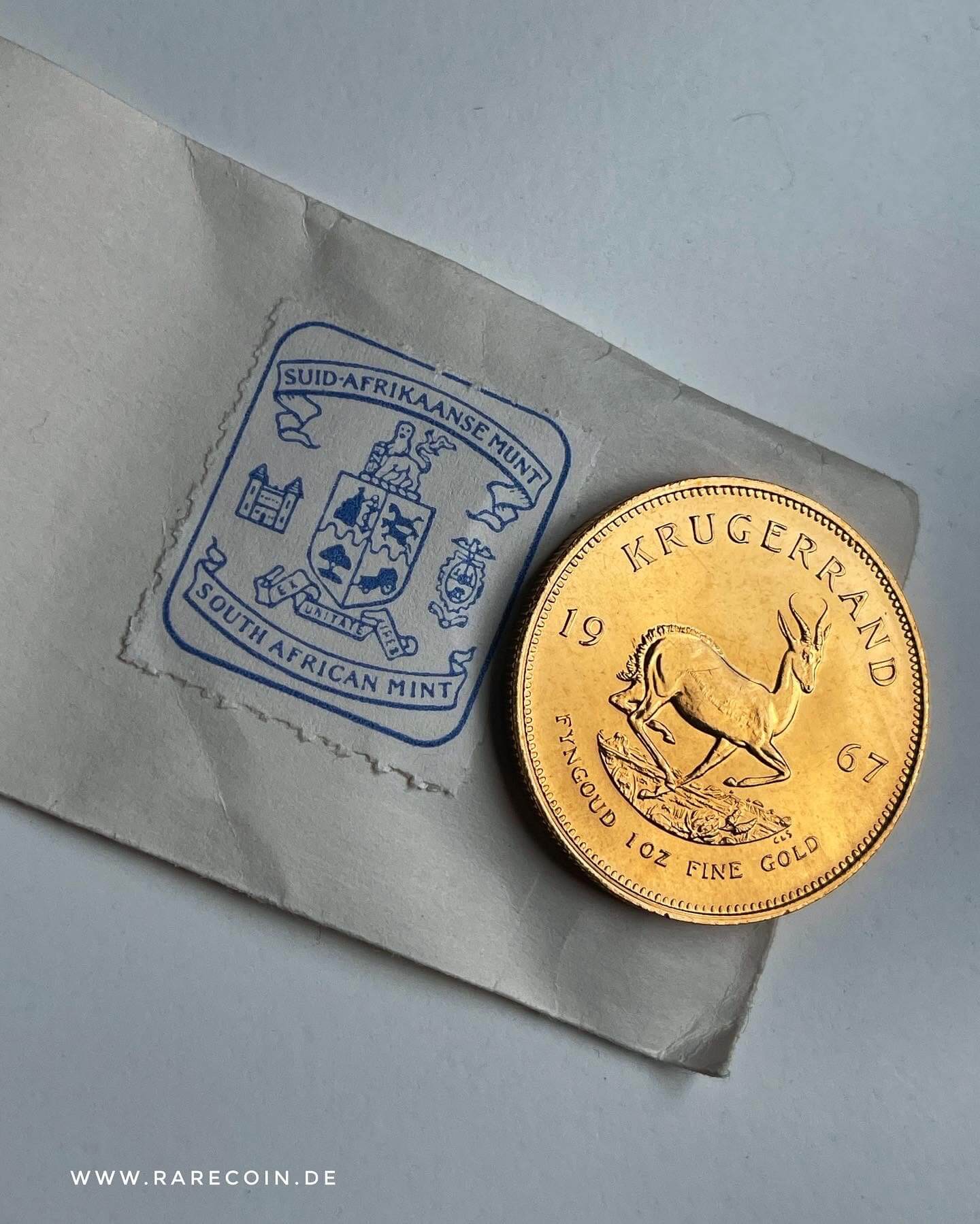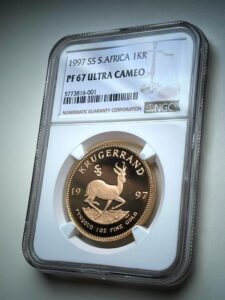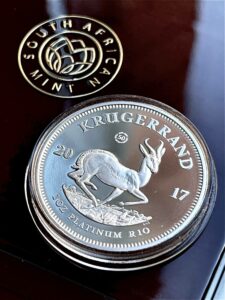
In 1967, the gold-rich country of South Africa issued its Krugerrand, the world’s first bullion coin. The idea behind it was simple, but genius: instead of a denomination, the coins were marked with the fineness (1 ounce). This is because, much like small ingots, they were traded at the current gold price. Numerous competitors have emerged on the market since then, but the Krugerrand remains one of the most successful bullion coins in the world.
By now, this bullion coin has its own history spanning over 50 years, which has now become an integral part of modern numismatics. And hidden amongst the various issues are some great rarities, which investors and collectors should be on the lookout for. Dirk Wasserthal, Executive Director of RareCoin, specialises in the rarities of modern numismatics. He explains what collectors need to look out for when it comes to Krugerrands: “Since bullion coins are traded at the gold price, the condition doesn’t really matter. However, if a coin is in outstanding condition, preferably confirmed and protected by grading, the collector’s value may exceed the bullion value. This applies in particular to rare years of issue and to Proof issues. The latter were made specially for collectors and produced in much lower mintages, making them rarer. Especially on the US market, we are seeing more and more rare Krugerrand coins being graded. This is generally not yet the case in Germany, but things are beginning to change.”
Here are five of the rarest Krugerrands on the market, for which a well-informed collector or investor could get considerably more than the gold price.

Krugerrand from 1967
The first Krugerrands hit the market in 1967. Compared to the mintages of later years, which contained millions of pieces, the first mintage was still very low, with 50,000 pieces in circulation quality and 10,000 in Proof. Dirk Wasserthal explains: “In addition to the rarity, there’s also a certain magic about the first issue that factors into the price of these pieces. After all, this wasn’t just the first issue of a globally successful bullion coin – it was the first bullion coin ever! Collectors really value things like that. Issues in circulation quality are currently traded at prices ranging between 2,800 and 4,500 euros, though coins will usually only fetch the top prices if they have been graded by the NGC or PCGS. Proof issues can fetch up to 6,000 euros.” By the way, new Krugerrands currently sell for around 1,860 euros, depending on the dealer and exchange rate.

Proof Fractional Set from 1980
In 1980, a new concept was introduced for the Krugerrand coins. From that year onwards, they were also issued as fractionals, weighing 1/2, 1/4 and 1/10 ounces, in order to appeal to retail investors. At that time, these fractional coins were already being produced in mintages of several hundred thousand pieces, and are therefore not particularly rare – except for the Proof versions of the fractional coins. In the first year, each of these pieces was issued in a mintage of just 80. Dirk Wasserthal tells us more: “The pieces were only issued in the ‘Proof Fractional Sets’, which were sold to VIP guests at a special ceremony on 23 September 1980 by then Finance Minister Prof. Owen Horwood. The sets and the pieces they contain are so rarely found on the market that it is difficult to price them accurately. 15 years ago, one of these sets was traded for 8,000 euros. If a set is in an adequate condition and has been graded accordingly, today’s prices could even reach 9,500 to 10,000 euros.”

Krugerrands from 1992 and Other Apartheid Years
The Krugerrand is part of South Africa’s history – and, in turn, this history also impacted the Krugerrand. In the 1980s, there was a growing protest movement against the racist Apartheid regime in South Africa. This resulted in international boycotts, which also affected the Krugerrand. Sales plummeted, as did mintages. In the 1970s, mintages had grown to 6 million specimens a year, but during the years of the boycott (1985 to 1999), this number fell below 100,000. The coins issued in these years are naturally very rare, making them valuable to collectors. Dirk Wasserthal explains: “Some of the rarest Krugerrands are those from the year 1992, during which we estimate that just 3,870 specimens were minted in circulation quality and 2,067 in Proof. We can’t be sure of the exact numbers, since many of the coins were also melted down again. For a Proof Krugerrand from 1992, you’ll be paying 6,000 or even close to 8,000 euros, depending on the dealer, and assuming that the piece is perfectly preserved and graded.” It wasn’t until the early 2000s that the mintages began to significantly increase again.

Krugerrand from 1997 – Sabi Sabi
In 1997, South Africa celebrated the 30th anniversary of the Krugerrand, and issued the first two special editions of the already legendary coin to mark the occasion. One of them is dedicated to Sabi Sabi, a private game reserve that borders the Kruger National Park. The motif is identical to that of the normal Krugerrand, except that, in addition to the image of the springbok, the reverse also bears the monogram “SS” for “Sabi Sabi”.
Dirk Wasserthal from RareCoin explains why the piece is so rare: “Originally, there were supposed to be 300 pieces in Proof, but in the end, only 72 were minted! The mintage of this commemorative edition therefore remains the lowest of all Krugerrand coins. Several other of these “mint mark” issues have been produced since then. For example, there was one in 2015 to mark the 50th anniversary of Sir Winston Churchill’s death (mintage: 200 specimens) and another in 2016 to celebrate the 90th birthday of Queen Elizabeth (mintage: 260 specimens). In terms of price, these issues currently fetch around 3,000 to 4,500 euros due to their rarity.” Special editions are still issued in low mintages today and are expected to increase in collector’s value. Dirk Wasserthal says: “It’s worth looking for these coins. Mint marks bring in a lot of money!”

Krugerrand from 2017 – Platinum Edition
Another anniversary meant another reason to do something special. In 2017, the Rand Refinery celebrated 50 years of the Krugerrand. That year, new denominations were added to the coin programme – and for the first time, the Rand Refinery also minted the Krugerrand in platinum and silver. But if anyone thought that the Rand Refinery would follow the example of other bullion coins and start issuing platinum coins every year, they were mistaken. The platinum Krugerrands were only issued in 2017. That year, 2,017 specimens were produced, all of them in Proof and bearing a mint mark to commemorate the 50th anniversary. Dirk Wasserthal explains: “These specimens are traded at a price of around 4,000 euros. Normal platinum bullion coins with the same fineness, such as the Maple Leaf or the American Eagle, on the other hand, can be purchased for 1,300 to 1,600 euros. So don’t go selling any of these pieces for the bullion price!”
In conclusion, it’s always worth looking very carefully at the coins you find, and it’s also a good idea to take them to a specialist who understands how to reflect the rarity of a coin in its purchase price.
You can find out more about RareCoin and the value of rare pieces on the company website.


